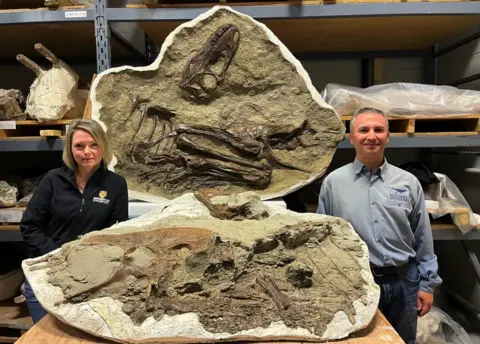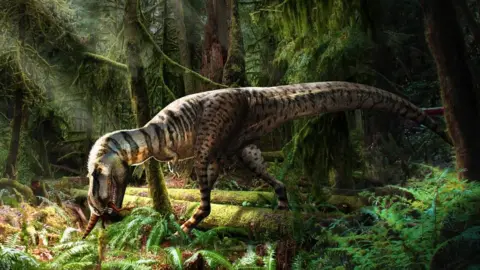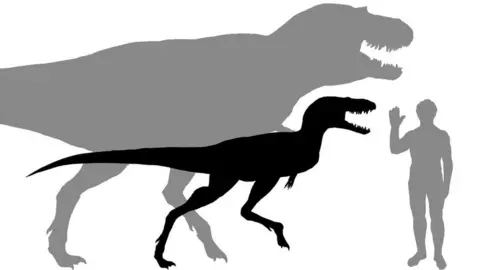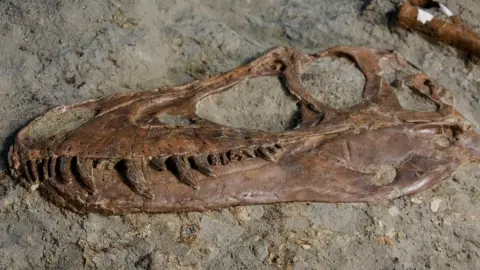Tyrannosaur’s last meal was two baby dinosaurs
 Royal Tyrell Museum of Palaeontology
Royal Tyrell Museum of PalaeontologyThe last meal of a 75-million-year-old tyrannosaur has been revealed by scientists - two baby dinosaurs.
Researchers say the preservation of the animal - and of the small, unfortunate creatures it ate - shines new light on how these predators lived.
It is "solid evidence that tyrannosaurs drastically changed their diet as they grew up," said Dr Darla Zelenitsky, from the University of Calgary.
The specimen is a juvenile gorgosaurus - a close cousin of the giant T. rex.

This particular gorgosaur was about seven years old - equivalent to a teenager in terms of its development. It weighed about 330kg when it died - about a tenth of the weight of a fully-grown adult.
The hind limbs of two, small bird-like dinosaurs called citipes are visible beneath its ribcage.
"We now know that these teenage [tyrannosaurs] hunted small, young dinosaurs," said Dr Zelenitsky, one of the lead scientists in this study, which is published in the journal Science Advances.
 Julius Csotonyi
Julius CsotonyiAn array of earlier fossil evidence, including evident bite marks on the bones of larger dinosaurs that match tyrannosaur teeth, have allowed scientists to build a picture of how the three-tonne adult gorgosaurs attacked and ate very large plant-eating dinosaurs which lived in herds.
Dr Francois Therrien, from the Royal Tyrell Museum of Palaeontology, described these adult tyrannosaurs as "quite indiscriminate eaters". They probably pounced on large prey, "biting through bone and scraping off flesh," he told BBC News.
But, Dr Zelenitsky, added, "these smaller, immature tyrannosaurs were probably not ready to jump into a group of horned dinosaurs, where the adults weighed thousands of kilograms".
'Toes poking through the ribcage'
The fossil was originally discovered in the Alberta Badlands in 2009 - a hotspot for dinosaur hunters.
Entombed in rock, it took years to prepare and it wasn't immediately obvious that there was prey inside. Staff at Alberta's Royal Tyrell Museum of Palaeontology eventually noticed small toe-bones sticking out from the ribcage.
"The rock within the ribcage was removed to expose what was hidden inside," explained Dr Therrien, who is the other lead scientist in this study. "And lo and behold - the complete hind legs of two baby dinosaurs, both under a year old."
Dr Zelenitsky said that finding only the legs suggested that this teenage gorgosaurus "seems to have wanted the drumsticks - probably because that's the meatiest part".
 Royal Tyrell Museum of Palaeontology
Royal Tyrell Museum of PalaeontologyThe gorgosaurus is a slightly smaller, more ancient species than T. rex. Fully grown, these were - as Dr Therrien put it - "big, burly tyrannosaurs".
They transformed as they matured. "Juveniles were much more lightly built - with longer legs and very blade-like teeth," he explained. "Adults' teeth are all much rounder - we call them 'killer bananas'.
"This specimen is unique - it's physical proof of the juveniles' very different feeding strategy.
While the adults bit and scraped with their powerful "killer banana" teeth, "this animal was selecting and even dissecting its prey - biting off the legs and swallowing them whole".
 Royal Tyrell Museum of Palaeontology
Royal Tyrell Museum of PalaeontologyProf Steve Brusatte, a palaeontologist from the University of Edinburgh and the National Museum of Scotland, said that seeing prey in the dinosaur's guts gave a real insight into the animals: "They weren't just monsters, they were real, living things and pretty sophisticated feeders."
Recalling a depiction of T. rex in the 1993 film Jurassic Park - where the giant dinosaur chased a car through the fictional theme park - Prof Brusatte added: "A big, adult T. rex wouldn't have chased after a car - if cars or jeeps were around back then - its body was too big, and it couldn't move that fast.
"It would be the youngsters - [like this gorgosaur] - the children of T. rex that you'd have to keep an eye on."
